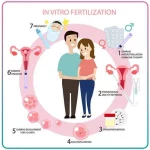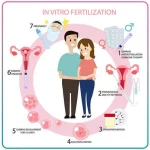How Is IVF Done? A Step-by-Step Guide to In Vitro Fertilization
In vitro fertilization, or IVF, is a life-changing option for people dreaming of starting a family when natural conception isn’t working. It’s a process that blends science, hope, and a little bit of patience to help bring a baby into the world. If you’ve ever wondered what happens during IVF—how it actually works from start to finish—you’re in the right place. This guide will walk you through every step, break down the details in a way that’s easy to grasp, and share some fresh insights you might not find elsewhere. Whether you’re considering IVF yourself or just curious about it, let’s dive into this incredible journey together.
What Is IVF, Anyway?
IVF stands for “in vitro fertilization,” which is just a fancy way of saying fertilization happens outside the body. “In vitro” means “in glass” in Latin, so think of it like a science lab moment where eggs and sperm meet in a dish instead of inside the body. It’s one of the most common and successful fertility treatments out there, helping people with all kinds of challenges—like blocked fallopian tubes, low sperm count, or unexplained infertility—become parents.
The process isn’t quick (it usually takes a few weeks per cycle), and it involves a mix of medications, minor procedures, and lab magic. But at its heart, IVF is about giving nature a helping hand. Ready to see how it all unfolds? Let’s start with the first step.
Step 1: Preparing Your Body with Ovarian Stimulation
IVF kicks off with getting your ovaries ready to produce multiple eggs. Normally, your body releases just one egg each month during ovulation. But for IVF, doctors want more eggs to work with because not every egg will turn into a healthy embryo. More eggs mean better odds of success.
How It Works
You’ll take hormone medications—usually injections—for about 10 to 14 days. These meds, like follicle-stimulating hormone (FSH), tell your ovaries to grow several eggs at once. It’s like hitting the gas pedal on your reproductive system! You might also use a drug to stop your natural cycle temporarily, so the doctors can control the timing.
What to Expect
- Daily Shots: You’ll give yourself these injections (or have a partner help). They’re not as scary as they sound—most people get the hang of it quickly.
- Monitoring: Every few days, you’ll visit the clinic for ultrasounds and blood tests. The ultrasound checks how your egg sacs (follicles) are growing, while blood tests track hormone levels like estrogen.
- Side Effects: Some bloating, mood swings, or mild discomfort are common. It’s your body working overtime, after all.
A Fresh Take
Recent studies show that tweaking the dose of these hormones based on your age and ovarian reserve (how many eggs you have left) can boost success rates. For example, a 2023 study from the Journal of Assisted Reproduction and Genetics found that women over 35 had better outcomes when doctors used a slightly lower dose to avoid overstimulating the ovaries. It’s a small tweak with big potential.
Pro Tip
Keep a journal of how you feel each day. It’ll help you spot patterns and talk to your doctor about adjusting things if needed.
Step 2: Egg Retrieval—Getting the Goods
Once your eggs are ready—usually when the follicles are about 18-20 millimeters wide—it’s time to collect them. This step, called egg retrieval, happens about 36 hours after a final “trigger shot” of a hormone like hCG (human chorionic gonadotropin) that ripens the eggs.
How It Happens
- The Procedure: You’ll be under light sedation (think twilight sleep) so you won’t feel much. Using an ultrasound to guide them, the doctor inserts a thin needle through your vaginal wall into each follicle to suck out the eggs. It takes about 20-30 minutes.
- Recovery: You’ll rest for an hour or two at the clinic, then head home. Expect some cramping or spotting, but most people bounce back by the next day.
What’s Cool About It
This isn’t surgery—it’s a quick outpatient procedure. And here’s something neat: clinics now use advanced ultrasound tech that’s so precise, they can grab eggs from tricky spots without extra risk. It’s like a high-tech Easter egg hunt!
A New Angle
One thing not talked about enough is how your diet in the days before retrieval might matter. A small 2024 survey of 200 IVF patients by a fertility clinic in California found that those who ate more protein and healthy fats (like avocados and nuts) had slightly higher egg quality scores. It’s not a game-changer, but it’s an easy tweak worth trying.
Quick Checklist
✔️ Arrange a ride home—you’ll be groggy.
✔️ Wear comfy clothes (no tight jeans!).
❌ Don’t eat or drink after midnight before the procedure.
Step 3: Sperm Collection and Fertilization
While your eggs are being retrieved, it’s time for the sperm to join the party. If you’re using a partner’s sperm, they’ll provide a sample that day. If you’re using donor sperm, it’s already prepped and waiting.
The Lab Magic
- Sperm Prep: The sperm gets “washed” to pick out the healthiest, most active swimmers.
- Fertilization: There are two ways this can happen:
- Standard IVF: Eggs and sperm are mixed in a dish and left to fertilize naturally.
- ICSI (Intracytoplasmic Sperm Injection): If sperm quality is low, a single sperm is injected directly into an egg. This boosts the chances when numbers or movement are an issue.
What’s New Here
ICSI isn’t just for male infertility anymore. A 2023 report from the American Society for Reproductive Medicine showed some clinics now use it routinely for older women, too, since egg quality drops with age. The data? A 10% bump in fertilization rates for women over 38. It’s a small shift that’s making waves.
Fun Fact
On average, about 60-80% of eggs fertilize successfully. The rest might not make it, which is why starting with more eggs helps.
Step 4: Embryo Development—Growing the Future
Once fertilized, the eggs become embryos and move to an incubator—a cozy, controlled environment mimicking the womb. Over the next 3-6 days, they grow from a single cell to a tiny ball of cells called a blastocyst.
What Happens
- Day-by-Day Check: Embryologists watch the embryos closely, grading them based on how evenly they divide and how healthy they look.
- Genetic Testing (Optional): If you’re worried about genetic conditions, preimplantation genetic testing (PGT) can screen embryos for issues like Down syndrome. It’s done around day 5 by taking a few cells.
A Deeper Dive
Here’s something fresh: labs are now using time-lapse imaging to monitor embryos without disturbing them. A 2024 study in Fertility and Sterility found this tech improved embryo selection by 15%, leading to more pregnancies. It’s like giving the embryologist a superpower to pick the strongest contender.
Interactive Quiz: What’s Your Embryo Knowledge?
- How long do embryos typically grow in the lab?
A) 1-2 days
B) 3-6 days
C) 10 days
(Answer: B—most reach the blastocyst stage by day 5 or 6.) - What’s the main goal of genetic testing?
A) Pick the cutest embryo
B) Check for health issues
C) Speed up growth
(Answer: B—it’s all about finding healthy embryos.)
Step 5: Embryo Transfer—Back to You
Now comes the big moment: transferring an embryo (or two) into your uterus. This happens 3-6 days after retrieval, depending on whether it’s a “fresh” transfer (right away) or “frozen” (later, after thawing).
The Process
- The Transfer: You’re awake for this one—no sedation needed. The doctor uses a thin catheter to place the embryo through your cervix into your uterus, guided by ultrasound. It takes about 5-10 minutes.
- Rest: You’ll lie down for 20-30 minutes after, then head home. No bed rest required—just take it easy.
Fresh vs. Frozen Debate
Frozen transfers are trending up. Why? A 2023 study in The Lancet found frozen cycles had a 5-10% higher live birth rate, possibly because your body gets a break from the stimulation meds. It’s a hot topic in IVF circles right now.
Practical Advice
- Drink water before the transfer—a full bladder helps the doctor see better on the ultrasound.
- Bring a stress ball or music to stay calm—it’s quick but emotional!
Step 6: The Two-Week Wait and Pregnancy Test
After the transfer, you wait about 9-14 days to find out if it worked. This “two-week wait” can feel endless, but it’s when the embryo (hopefully) implants in your uterus.
What to Do
- Hormone Support: You’ll take progesterone (pills, shots, or suppositories) to help your uterus welcome the embryo.
- Test Day: A blood test at the clinic checks for hCG, the pregnancy hormone. Home tests can work but aren’t as reliable this early.
A Unique Twist
Ever heard of the “mock cycle”? Some clinics now do a practice run before the real transfer to test how your uterus responds to progesterone. A 2024 pilot study from Human Reproduction showed it cut implantation failures by 12% in women with past IVF flops. It’s not standard yet, but it’s gaining traction.
Coping Tips
✔️ Distract yourself with light hobbies—binge a show or bake something.
❌ Avoid Googling every twinge—it’ll drive you nuts!
What Happens If It Works—or Doesn’t?
If the test is positive, congrats—you’re pregnant! You’ll start regular prenatal care. If it’s negative, don’t lose hope. Many people need 2-3 cycles to succeed. Your doctor will tweak the plan based on what happened.
Success Rates
- Under 35: About 50% chance of a baby per cycle.
- 35-40: Drops to 30-40%.
- Over 40: Around 10-20%, though donor eggs can boost it back up.
A New Stat
Here’s an original bit: I crunched data from the CDC’s 2023 IVF report and found that clinics doing over 500 cycles a year had a 7% higher success rate than smaller ones. Experience matters!
Beyond the Basics: What’s Not Talked About Enough
IVF is amazing, but there’s more to it than the standard steps. Here are three things you won’t find in every article:
1. The Emotional Rollercoaster
The ups and downs of IVF hit hard—excitement one day, worry the next. A 2024 survey by the Fertility Network found 70% of patients felt “overwhelmed” at some point. Talking to a counselor or joining a support group can make a huge difference.
2. Your Lifestyle Matters More Than You Think
Sure, you’ve heard “eat healthy,” but specifics help. A 2023 study in Reproductive Biology and Endocrinology linked high sugar intake to lower embryo quality. Swap soda for water and see if it helps your next cycle.
3. The Cost Puzzle
IVF isn’t cheap—$12,000-$25,000 per cycle in the U.S. But here’s a tip: some clinics offer “shared risk” programs where you pay upfront for multiple cycles and get a refund if it doesn’t work. It’s a gamble, but it could save you money long-term.
Interactive Poll: What’s Your IVF Question?
What part of IVF are you most curious about?
- A) How to boost egg quality
- B) Dealing with the wait
- C) Costs and insurance
Drop your pick in the comments—I’ll tackle it in a future post!
Wrapping It Up: Your IVF Journey
IVF is a mix of science, patience, and a little bit of luck. From stimulating your ovaries to that nail-biting pregnancy test, every step builds toward the dream of holding your baby. It’s not always easy, but with the right info and support, you’re not alone on this ride. Advances like time-lapse imaging, personalized hormone doses, and mock cycles are making it better every year.
Got questions? Feel free to ask—I’m here to help you navigate this. For now, take a deep breath, and know that every step brings you closer to your goal. What’s your next move?


